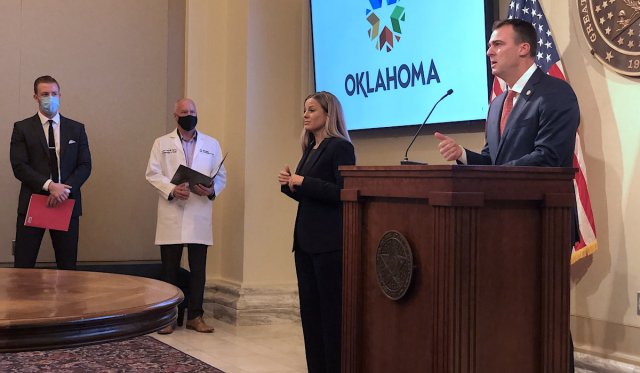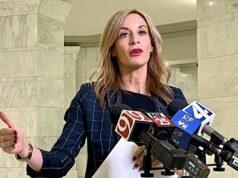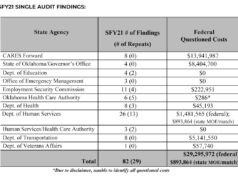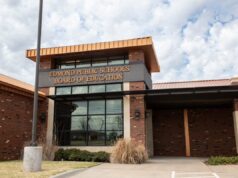

Oklahoma Gov. Kevin Stitt said today that, starting Feb. 22, COVID-19 vaccines will become available to pre-K through 12th grade teachers, school staff and Oklahomans younger than 65 who have health conditions that put them at high risk for complications from the novel coronavirus.
“I know this has been a really tough year for parents, for students, for teachers, for staff all across our state,” Stitt said regarding vaccinations for teachers. “And that’s why I’m proud to be able to get this vaccine out as quickly as possible. Each day that goes by, we learn more and more about how important it is to get kids safely back in the classroom.”
These new populations are part of the second phase of the state’s vaccination plan, which started in early January. Previously, vaccines have been available to residents of long-term care facilities, frontline medical and public health workers and Oklahomans over the age of 65.
Deputy Commissioner of Health Keith Reed said the state estimates there are 89,000 teachers and school staff who will be newly eligible for vaccination and more than 1 million with comorbidities.
“I do also want to emphasize that this portion of Phase 2 will likely take some time to complete,” Reed said, warning that even newly eligible populations may have a wait ahead of them until vaccine supplies increase.
Commissioner of Health Dr. Lance Frye encouraged people to register with the state’s vaccine scheduling portal, which will alert users when they are eligible to be vaccinated as well as sending out appointment and booster-shot reminders.
Vaccines for teachers
When Oklahoma first rolled out its vaccine program in early December, teachers and school staff were relegated to Phase 3. They were soon moved up the priority list as part of Stitt’s push to get students back in classrooms as soon as possible.
The return to in-person learning has been a contentious issue for several months, and Stitt’s criticisms of school districts that have delayed reopening have been met with opposition from some teachers’ groups, including the Oklahoma Education Association.
Thursday, OEA President Alicia Priest expressed approval of the move to begin vaccinating teachers.
“We’re glad the governor has followed the lead of other governors across the country by prioritizing school workers,” she said in a statement. “Educators have been outspoken in their advocacy for concrete actions to keep our schools open safely. We are grateful the governor has listened and taken this critical step.”
Superintendent of Public Instruction Joy Hofmeister said vaccinating teachers is an important step, but she added that vaccines along will not be sufficient to ensure safe returns to the classroom.
“Our teachers and support staff deserve and need to work in a safe and secure environment,” Hofmeister said in a statement. “Giving them this opportunity to receive the vaccine as soon as reasonably possible is critical. While in-person school is more dependent on COVID mitigation strategies such as masks and social distancing , ensuring the vaccination of teachers is vital to keeping school doors open. I urge all Oklahomans, teachers and non-teachers alike, to welcome the vaccine as soon as they are eligible.”
The latest guidance from the Centers for Disease Control on school re-openings states, “The many benefits of in-person schooling should be weighed against the risks of spreading COVID-19 in the school and community.” The CDC also recommends a number of measures to help prevent the spread of COVID-19 in schools, including continuing to offer virtual learning where appropriate.
House Minority Leader Emily Virgin (D-Norman) said during a press conference that she was “really encouraged” by the progress in vaccination, but cautioned that vaccines are not a silver bullet to enable safe school reopening.
“By including teachers in this (debate over school reopening), it’s creating another wedge issue,” she said. “That’s not how vaccines work. It takes time to build up immunity.”
Vaccines for teachers and school staff will be distributed through clinics set up in coordination with local school systems. Frye said the goal is to get vaccines to any teacher who wants one before spring break.
Oklahomans with comorbidities will have access
The larger population affected by Thursday’s announcement is Oklahomans who have health conditions that make them particularly vulnerable to COVID-19.
Frye said the list of eligible comorbidities for this stage includes but is not limited to:
- hypertension
- obesity
- cardiovascular disease
- diabetes
- chronic lung, liver and renal disease
A fuller list of comorbidities, from the CDC, includes cancer, pregnancy, smoking, asthma and others.
Reed said the hope is that patients at risk of comorbidities will be identified and referred by physicians. He acknowledged, however, that there is a risk of people jumping the line by lying on the appointment portal screener about having a health condition.
“It’s inherent in the system, when we’re trying to vaccinate the entire state of Oklahoma, that we’re going to have some issues like that,” he said. “And we don’t want to create a system that becomes so restrictive just to try to eliminate a few of those that are abusing the system. We don’t want a system that is so restrictive that it cuts down on our efficiency moving forward.”
Oklahoma vaccinating faster than most states
Though Oklahoma has had one of the highest COVID-19 infection rates in the country during the pandemic, it has also achieved one of the highest vaccination rates, with approximately 11 percent of the population having received at least one vaccine shot.
Stitt said 441,000 Oklahomans have received their first vaccine dose, and 167,000 have received both initial and booster doses.
Reed added that, with state, federal and tribal distributions all included, 56 percent of Oklahomans over the age of 65 have received at least one shot.
One reason the program is moving quickly is that the state has prioritized speed over strict adherence to distribution priorities. This has allowed localities to move forward through the phases at their own pace. It also means that the state takes what Reed called “an overlapping approach” to its distribution phases.
“We begin the next priority group prior to finishing the current one, “he said. “This ensures we maintain proper momentum while accounting for the difficulty in predicting uptake rates and possible vaccine hesitancy.”
Reed emphasized that vaccines will remain available to people who qualify under previous phases. He said ramping up vaccination efforts is still largely dependent on increased supply, including the potential FDA approval of a new vaccine by Johnson & Johnson that does not require a booster shot.




















